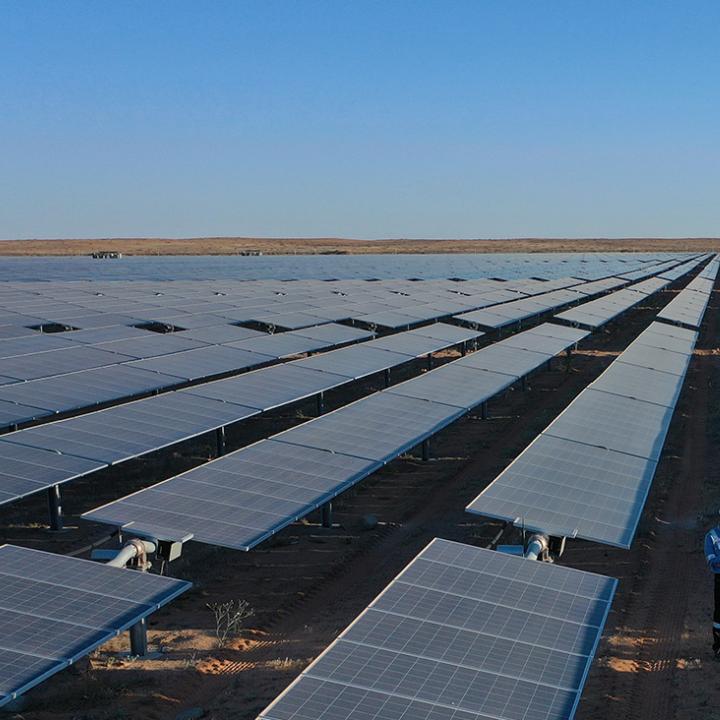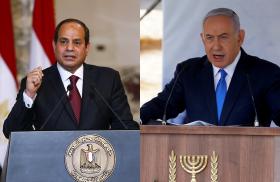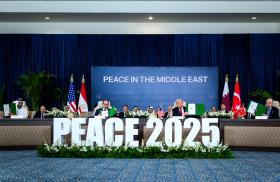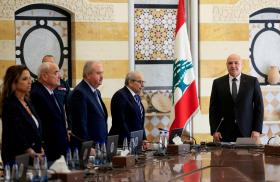
- Policy Analysis
- Articles & Op-Eds
A New Energy Order in the UAE and Saudi Arabia
Also published in Petroleum Economist

The two Gulf states are combining fossil fuel production with ambitions to become low-carbon leaders, and Washington risks getting left behind if it ignores the trend.
A new chapter for energy is being drafted in Saudi Arabia and the UAE, which US President Donald Trump visited in May. Oil and gas remain king in these two Gulf states, but they are no longer the only dominant theme in the energy landscape.
As the new US administration prioritises fossil fuels and rolls back grants and tax credits for low-carbon energy, the UAE and Saudi Arabia have found a way to combine the two. By capitalising on the economic and market opportunities of renewables and low-carbon technologies, they are now part of a new energy order that is taking shape with significant geopolitical implications. Ignoring this new model means being left behind. US adversaries, such as China, are not only part of this new order, but in a dominant position within it.
Hydrocarbons continue to be the main source of revenues for Arab Gulf states. The region’s overall supply of oil (crude and oil products) and LNG to global markets also remains critical—around 30% of global seaborne oil exports and about 20% of LNG are exported from the Gulf. Meanwhile, oil production decisions by the Saudi-led OPEC and its market allies are closely monitored given their impact on global oil prices and investment.
That said, Saudi Arabia and the UAE have been heavily investing in renewables, battery energy storage systems (BESS), and carbon capture and storage (CCS), in addition to nuclear energy and green hydrogen (produced through electrolysis using renewables), among other technologies. These will continue to play a key role in global energy diversification efforts and amid the forecast growth in global electricity demand, “growing at close to 4% annually through 2027,” mainly driven by data centres, electrification, and other factors, according to the IEA. Simply put, the two states continue to promote fossil fuels while also seizing the economic opportunities in low-carbon technologies.
Investment Partnerships
The Gulf states are also investing in global markets and forging investment partnerships with leading companies, including in the US. For instance, in September 2024, ADQ, an Abu Dhabi-based sovereign wealth fund that focuses on critical infrastructure and global supply chains, struck an agreement with US-based Energy Capital Partners, an energy transition investor, to set up a 50/50 partnership in newbuild power generation and energy infrastructure, partly to address future electricity demand from data centres and energy-intensive industries. Furthermore, the UAE and Saudi Arabia have also been investing in critical minerals that are fundamental for clean energy technologies, including electric vehicles, in a world where China controls the supply chain.
But the Gulf region has its own definition of energy transition. For Saudi Arabia, its energy transition began in the 1970s with the development of the Master Gas System. Former Saudi oil minister Ali al-Naimi said in his 2016 memoir Out of the Desert that the “cornerstone” of Saudi Arabia’s second five-year plan, announced in 1975, was the massive Master Gas plan. The main objective behind this project was to diversify an oil-dependent economy through capturing valuable gas associated with oil production that was flared off at oilfields and using it to fuel the country’s industrialisation. And the Kingdom continues to develop this Master Gas System while also reinventing its energy sector.
Last year, Saudi Energy Minister Abdulaziz bin Salman emphasised this transition, which today is based on what he called in his presentation “key pillars”: energy efficiency enhancement, energy mix transformation, and emissions management. The process seeks to balance energy security, energy access and availability, and sustainability and climate action. So instead of exporting only oil, Saudi Arabia wants to become an exporter of “all forms of energy,” including low-carbon products.
The expected growth in the Kingdom’s renewables capacity is worth watching. According to data published by the Middle East Economic Survey (MEES) newsletter in February, the Kingdom’s renewables capacity is expected to jump to 12.7GW by the end of this year from around 6.5GW now. The renewables projects include the Layla solar PV plant (91MW), which according to MEES is being developed by Saudi and Chinese firms. This growth in renewables will also be accompanied by battery storage deployment to address the issue of intermittency associated with variables such as solar and wind energy.
Saudi Arabia boasts low prices in both wind and solar, with one solar project having a price of $0.0129/KWh. The low levelised cost of electricity of renewables could put the Kingdom in a strong position to export green hydrogen in the future, despite doubts surrounding the potential of this technology in general due to factors related to market demand, costs, and infrastructure. Saudi Arabia is already building a massive green hydrogen project in Neom, in the northwest on the Red Sea—a region where Yemen’s Houthis have been staging a maritime campaign against global shipping and launching long-range missiles against Israel.
Nuclear Story
In the UAE, the story of nuclear energy deserves attention, especially when it is making a comeback, including in the US. The UAE is the only Arab country with an operable civilian nuclear energy facility that is playing a key role in power generation—providing about 25% of the country’s power needs. While Iran has given nuclear a bad name due to the serious concerns about its nuclear intentions and lack of transparency, the UAE has presented a successful model through its 5.6GW Barakah plant.
When US Secretary of Energy Chris Wright kicked off his first official tour of the Middle East in April, I recounted in an analysis the UAE’s responsible and cooperative nuclear approach, highlighting the opportunities for both Abu Dhabi and Washington when it comes to nuclear cooperation. AI-driven energy demand is expected to rise exponentially, including in the US market, and more power will be needed—which reliable, flexible nuclear will be well-placed to provide. The UAE, which aspires to become an influential AI player and to that end signed an AI agreement with the US during Trump’s recent visit, has also been eyeing collaboration with US companies over advanced nuclear technology, such as TerraPower’s Natrium technology.
The UAE has reached a stage where it is not only interested in building nuclear plants domestically, but also seeks to become a player in the global market. In an interview with the Financial Times earlier this year, Mohamed al-Hammadi, who leads the Emirates Nuclear Energy Company, said: “We want to capitalise on our success and we are looking at what we can do: build in the UAE, outside the UAE, the whole market.”
Energy developments in the two Gulf states are driven by heavy government support and funding, private investments, and sustained innovation induced by research and development. These energy transformations are expected to reshape the geopolitical map, according to the International Renewable Energy Agency—in the same way fossil fuels did in the past—and they can hardly be ignored. They provide the US with opportunities for more partnerships in all forms of energy.
Noam Raydan is a senior fellow at The Washington Institute and co-creator of its Maritime Spotlight platform. This article was originally published on the Petroleum Economist website.



